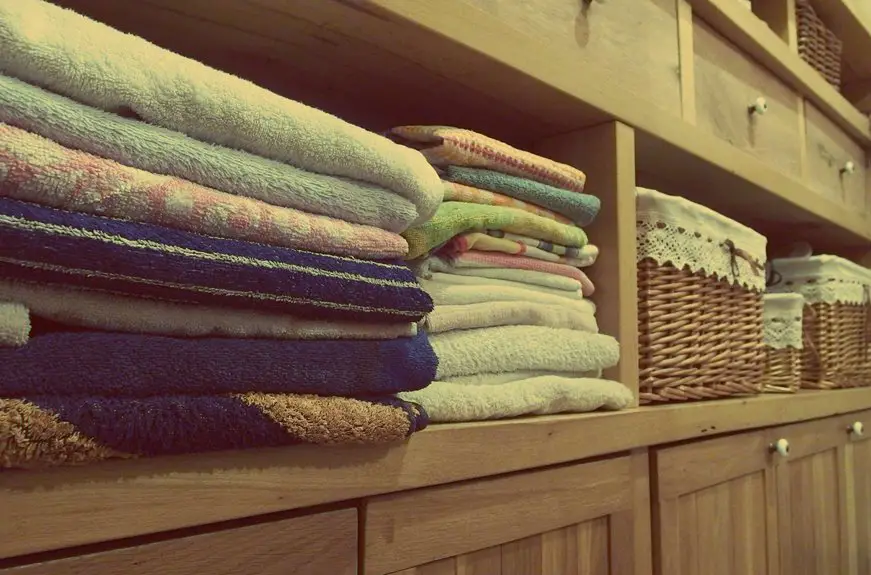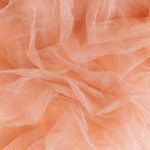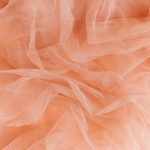When buying linen gauze fabric by the yard, choose one that balances lightness and durability with a breathable, loosely woven texture. Look for even weaving and natural color variations that signal quality. Pick the right weight and weave for your garment’s style, and pre-wash to prevent shrinkage. Use sharp needles and gentle stitching to handle its delicate fibers. Keep these tips in mind, and you’ll find plenty of expert advice to make your project shine.
Table of Contents
Key Takeaways
- Choose linen gauze with an even, consistent weave and natural color variations for authentic, durable fabric.
- Select weight and weave based on project needs: lightweight for airy garments, medium for structure, loose for sheerness.
- Inspect fabric softness and sturdiness; avoid rough or flimsy textures to ensure quality and comfort.
- Pre-wash fabric using cold water and mild detergent to prevent shrinkage and reveal true fabric behavior.
- Buy fabric with neat selvedges and inquire about thread count and fiber content for long-lasting results.
Understanding Linen Gauze Fabric: Characteristics and Benefits
Linen gauze fabric offers a unique combination of lightness and durability that makes it ideal for various uses. When you work with it, you’ll notice its loosely woven texture, which allows excellent breathability and a soft, airy feel.
This fabric’s natural fibers make it highly absorbent and moisture-wicking, perfect for warm weather garments or delicate accessories. Plus, its strength guarantees it holds up well over time despite its lightweight nature.
You’ll also appreciate how linen gauze drapes beautifully, adding an elegant, effortless touch to your projects. Since it’s made from flax, it’s eco-friendly and becomes softer with washing.
Understanding these characteristics helps you appreciate why linen gauze is a favorite among sewists seeking both comfort and durability in their fabric choices.
How to Choose the Right Weight and Weave for Your Project
When selecting gauze fabric for your project, paying attention to the weight and weave can make all the difference in the final result.
Lightweight linen gauze works well for breezy garments like summer tops or scarves, offering softness and breathability. If you need more structure, choose a medium-weight gauze; it holds shape better, ideal for dresses or blouses.
The weave affects texture and transparency—looser weaves create a sheer, airy look, perfect for layering, while tighter weaves provide modesty and durability.
Consider how your project will be used and how much drape or stiffness you want. By matching the linen gauze’s weight and weave to your design’s needs, you guarantee comfort, functionality, and style in your finished piece.
Tips for Selecting Quality Linen Gauze by the Yard
Although gauze fabric can look similar at first glance, you’ll want to examine several key factors to guarantee you’re getting high-quality linen gauze by the yard.
First, check the weave closely—quality linen gauze has an even, consistent weave without loose yarns or gaps.
Feel the fabric; it should be soft yet sturdy, not rough or flimsy.
Look for natural color variations that indicate authentic linen rather than synthetic blends.
Don’t hesitate to ask about the thread count and fiber content—both impact durability and drape.
Finally, inspect the selvedges; they should be neat and intact, signaling careful manufacturing.
Pre-Washing and Care Considerations Before Cutting
Before you start cutting your linen gauze, it’s essential to pre-wash the fabric to prevent future shrinkage and color bleeding.
You’ll want to use a gentle cycle with cold water and a mild detergent to keep the fabric’s texture intact.
Taking these steps guarantees your final project maintains its shape and quality over time.
Importance of Pre-Washing
Since linen gauze fabric can shrink and change texture after its first wash, you’ll want to pre-wash it before cutting to confirm your finished project fits and feels just right.
Skipping this step risks ending up with garments or items that no longer match your measurements or desired drape. Pre-washing also helps remove any residual chemicals or sizing agents left from manufacturing, which can affect dye absorption and fabric softness.
Additionally, it reveals how the fabric behaves—whether it softens, stiffens, or changes color—allowing you to adjust your sewing plans accordingly. Taking the time to pre-wash guarantees accuracy, prevents surprises, and ultimately improves the durability and comfort of your linen gauze creations.
Don’t overlook this essential step before you start cutting.
Best Washing Techniques
Washing linen gauze fabric properly involves a few key steps to preserve its texture and size. First, always pre-wash your fabric before cutting to prevent future shrinkage and maintain softness. Use cold water and a gentle cycle to protect the delicate fibers. Avoid harsh detergents and bleach, which can weaken the fabric.
| Step | Water Temp | Detergent Type |
|---|---|---|
| Pre-wash | Cold | Mild, liquid |
| Rinse | Cold | None |
| Drying | Air dry flat | Avoid direct sun |
After washing, gently squeeze out excess water; don’t wring. Lay the fabric flat to dry away from direct sunlight to keep colors vibrant and fibers strong. Following these tips guarantees your linen gauze stays beautiful and ready for sewing.
Best Sewing Techniques for Working With Linen Gauze
Mastering just a few key sewing techniques can make working with linen gauze much easier and more enjoyable.
Since linen gauze is lightweight and loosely woven, you’ll want to use sharp needles, like size 70/10 or 60/8, to prevent snagging. Use a fine polyester thread and a shorter stitch length to maintain fabric integrity.
Use sharp needles and fine thread with short stitches to protect lightweight, loosely woven linen gauze from snags.
French seams or flat-felled seams are your best friends here—they enclose raw edges neatly, preventing fraying. Stabilize your fabric with tissue paper or a water-soluble stabilizer when cutting and sewing to avoid distortion.
Press seams gently with a low heat iron, using a pressing cloth to protect the delicate fibers. These techniques will help you create clean, durable projects without frustrating fabric shifts or frays.
Creative Project Ideas Using Linen Gauze Fabric
If you’re looking to add a light, airy touch to your projects, linen gauze fabric offers endless creative possibilities.
You can craft elegant summer scarves that drape beautifully or design breezy blouses perfect for warm weather. Linen gauze also works wonders for sheer curtains, letting in soft natural light while maintaining privacy.
Consider layering it to create delicate shawls or wraps that add texture without weight. For home decor, you can sew lightweight table runners or napkins with a rustic charm.
If you’re into accessories, try making fabric flowers or lightweight tote bags. Its breathable nature makes it ideal for baby clothes and swaddles too.
With linen gauze, your projects will feel fresh, sophisticated, and effortlessly stylish.
Frequently Asked Questions
Where Can I Buy Linen Gauze Fabric Online With International Shipping?
Imagine ordering linen gauze fabric online like sending a telegram. You can find it on Etsy, Fabric.com, or Mood Fabrics, all offering international shipping, so you won’t have trouble getting quality fabric delivered to your doorstep.
How Is Linen Gauze Fabric Different From Cotton Gauze Fabric?
You’ll find linen gauze is more breathable and durable, with a natural texture, while cotton gauze feels softer and lighter. Both are airy, but linen handles moisture better and gets softer with each wash.
Can Linen Gauze Fabric Be Used for Upholstery Projects?
You shouldn’t use linen gauze for upholstery since it’s lightweight and sheer. It lacks the durability and structure needed for furniture. Instead, choose heavier, tightly woven fabrics designed to withstand wear and tear.
What Environmental Impact Does Linen Gauze Production Have?
Think of linen gauze production as nature’s gentle whisper—flax cultivation uses less water and pesticides than cotton, so you’re choosing a fabric with a lighter footprint, supporting sustainable practices that nurture the earth rather than draining it.
Are There Any Allergy Concerns With Linen Gauze Fabric?
You might not worry much about allergies with linen gauze fabric since it’s naturally hypoallergenic and breathable. However, if you’re sensitive to flax or have skin conditions, test a small patch before using it extensively.
- Why You Should Consider Double White Cotton Gauze for Your Next Project - June 14, 2025
- Understanding the Unique Weave of Olive Silk Gauze Fabric - June 14, 2025
- The Best Online Stores for Teal Gauze Fabric by the Yard - June 14, 2025







